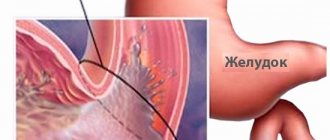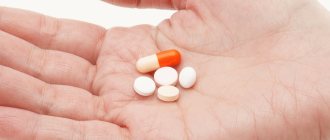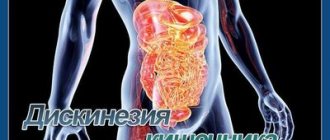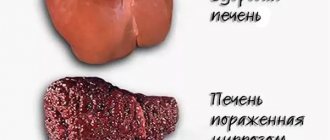Many patients are familiar with pain in the epigastric region (scientifically, in the epigastrium): aching, pulling, burning or spastic. Sometimes this pain is combined with a feeling of early satiety, with a feeling of fullness in the stomach even after eating a regular or small amount of food. “Typical symptoms of gastritis,” many readers of our blog will think, and they will be wrong.
The described complaints are characteristic of functional dyspepsia , a disease that many patients and, alas, doctors (including gastroenterologists) still incorrectly call “chronic gastritis.”
Let's try to figure out what the essence of the problem is.
The stomach is a hollow organ whose wall has several membranes. The mucous membrane, the inner lining of the organ, is usually clearly visible during endoscopic examination (gastroscopy). During gastroscopy, various changes in the gastric mucosa are often detected: redness (hyperemia), swelling, submucosal hemorrhages, and sometimes erosion. The deeper layers, including the muscle layer, are not visible during standard gastroscopy, but it is this area of the stomach wall that plays an important role in the appearance of the symptoms described above.
Currently, the fact is generally accepted in the gastroenterological scientific world: there are two separate diseases - chronic gastritis and functional dyspepsia.
Chronic gastritis is the presence of inflammation and other changes (for example, atrophy) in the gastric mucosa, which is detected by morphological (histological) examination. To do this, pieces of mucosal tissue are taken during an endoscopic examination of the stomach and later examined by a pathologist. Changes in the stomach detected during gastroscopy are not a sign of chronic gastritis. Moreover, the presence of these changes (hyperemia, edema, and even erosion) is often not associated with epigastric pain and other symptoms that we talked about at the very beginning of the article. These are symptoms characteristic of functional dyspepsia.
What is functional dyspepsia (FD)? This is a chronic disease of the stomach, which is manifested by pain or burning in the upper abdomen, as well as other symptoms: a feeling of heaviness, fullness in the epigastrium after eating, a feeling of early satiety after eating. The main mechanisms for the development of FD include disruption of normal gastric muscle motility and increased sensitivity of the nerve endings (receptors) of the stomach to stretching. The latter mechanism, by the way, is very similar to the mechanism of pain development in irritable bowel syndrome.
It is uncoordinated muscle contractions in combination with the increased sensitivity of stretch receptors, as well as some other factors (for example, low pH values in the stomach due to increased production of hydrochloric acid) that lead to the appearance of pain and other unpleasant symptoms in FD.
In this case, diagnoses of FD and chronic gastritis can be observed simultaneously in one patient.
FD is quite common - about 20% of the population suffers from this disease. Most patients note a connection between symptoms and food intake. Thus, in one study, in 79% of patients with FD, symptoms characteristic of this disease intensified within 15 minutes after eating and persisted throughout the entire assessment period (4 hours).
This relationship between food intake and the appearance/increase of symptoms is often noted by patients independently and outside of clinical studies, often leading to a reduction in food intake, avoidance of food, and the emergence of a “fear of food.” Patients with FD often try to follow a diet (either independently selected or recommended by a doctor), but not always successfully.
We will try to figure out whether there is a connection between the increased symptoms of FD and the nutritional habits of patients.
Effect of Diet on FD Symptoms
The well-known “folk” recommendations not to eat hastily, to chew thoroughly, to eat regularly so as not to “get gastritis”, it turns out, have a scientific basis. True, only in relation to the same FD, and not chronic gastritis. Scientific research has proven that eating large amounts of food quickly and eating irregularly can increase the symptoms of FD. This is due to a disruption in the processes of contraction and relaxation of various parts of the stomach during food or liquid intake. There is even a so-called rapid drinking test, which reproduces the typical symptoms of FD when drinking a large volume of liquid in a short time and can confirm this diagnosis.
It is known that the basis for the appearance of FD symptoms may be a violation of accommodation of the stomach muscles, i.e. impairment of the ability of the muscles of the fundus of the stomach to relax after eating. As a result, food quickly enters the outlet (antrum) of the stomach and this can cause heaviness, fullness, and abdominal pain. The study showed that eating large amounts of food quickly and eating irregularly had the same risk of developing dyspepsia symptoms by 1.42 times.
There are works devoted to the influence of the temperature of food and drinks on the contraction of the stomach muscles. Thus, drinking cold liquid promotes contraction of the smooth muscles of the stomach, which can increase not only pain, but also the feeling of heaviness/fullness in the stomach.
Thus, the consumption of cold foods/drinks, as well as fast meals should be avoided in persons with FD, especially with the predominance of dyspeptic symptoms such as heaviness/fullness in the epigastrium after eating. Long breaks in eating (no more than 4 hours) should be avoided, since a pronounced feeling of hunger at the time of the next meal can contribute to overeating.
The effect of fatty foods on FD symptoms
Edible fat is consumed in various forms, depending on the nature of the food consumed and the temperature of the food. Foods high in fat are often associated with a simultaneous high content of carbohydrates (for example, confectionery) or protein (meat and processed products). It is known that in a healthy person, eating a high-fat meal is associated with a decrease in the rate of gastric emptying.
How do dietary fats affect FD symptoms? A 2008 study found that eating a high-fat diet was more associated with FD symptoms such as epigastric pain, nausea, bloating, and early satiety when compared with a high-carbohydrate diet. Moreover, both diets (high-fat and high-carbohydrate) were comparable in energy value (calorie content).
It is also known that cognitive factors influence the intensification or appearance of FD symptoms when consuming fatty foods. Thus, in one of the studies it was once again shown that consumption of foods with a high fat content significantly more often caused the appearance of symptoms of FD, compared with foods with low fat content. However, if patients ate low-fat foods, believing that they were high in fat, they also experienced dyspeptic symptoms.
Thus, patients with FD may be advised to follow a diet that limits foods containing high amounts of fat.
Reviews and results
Dietary nutrition for intestinal dyspepsia, according to customer reviews, helps improve intestinal function: reducing spasms, bloating, pain (colic), and normalizing stool.
- “... Complaints of flatulence, bloating against the background of frequent bowel movements. I went to the hospital, but they didn’t find anything special about me. They recommended going on a diet. I noticed that when I practice dietary nutrition, everything quickly returns to normal, on average, after 2-3 weeks, but as soon as I switch to my usual diet, everything starts again. It is probably necessary to undergo a more thorough examination in a paid clinic or, in addition to the diet, take folk remedies in the form of herbal decoctions or preparations based on them”;
- “... Cramps in the intestines and bloating for almost 2 months. At the same time, there is no bowel disorder. I went to the clinic and got tested. The doctor told me to follow a diet and prescribed Espumisan. To prepare dietary dishes, I purchased a multicooker. Everything cooks very quickly and turns out delicious. I excluded all fatty foods, sausages, flour, and sweets. For now I eat boiled chicken and fish, boiled and pureed vegetables. I eat little by little, I try to eat separately, that is, I don’t mix meat and cereals and bread into one meal. I take a decoction of chamomile and dill water. The condition is gradually improving. I think it’s better to watch your diet than to suffer with cramps.”
The effect of protein foods and gluten on FD symptoms
Currently, there is no proven connection between symptoms of FD and protein intake, so protein restrictions are not required for patients with this disease.
As for gluten, several studies have been conducted to identify a possible relationship between eating this protein and the development of symptoms of dyspepsia. This is due, on the one hand, to the high frequency of symptoms characteristic of FD in patients with celiac disease, as well as the frequent disappearance of dyspeptic manifestations against the background of a gluten-free diet. On the other hand, symptoms of FD occur in approximately 31-50% of individuals diagnosed with gluten hypersensitivity not associated with celiac disease. These patients report characteristic epigastric pain and nausea, heaviness and fullness after eating foods containing gluten.
Unfortunately, there are no high-quality studies demonstrating the effectiveness of a gluten-free diet on FD symptoms. The fact that patients with a proven diagnosis of celiac disease need to follow a gluten-free diet is immutable. If the doctor suspects that dyspeptic symptoms are manifestations of gluten hypersensitivity, a gluten-free diet can be recommended for 4-6 weeks with an assessment of symptoms. If symptoms have significantly decreased or completely disappeared, after analyzing the possible positive effects of other factors, this diet can be recommended for a longer period. The lack of effect of a gluten-free diet within 4-6 weeks indicates that the patient with FD does not require this diet in the future.
Effect of carbohydrates on FD symptoms
Only a small number of studies have looked at the relationship between FD symptoms and carbohydrate intake, and the results are inconsistent. One study reported that lower carbohydrate intake was associated with symptoms. Another study showed that daily carbohydrate intake in patients with FD differed little from that in the control group (230 g vs. 199 g/day). Finally, another authors reported no association between FD symptoms and high carbohydrate meals.
Due to the contradictory scientific data, it is currently impossible to draw a conclusion about the need to reduce or increase the amount of carbohydrates in the diet of patients with FD.
FODMAP Carbohydrates and FD Symptoms
The acronym FODMAP stands for a group of fermentable (F) carbohydrates – oligo- (O), di- (D) and monosaccharides (M), as well as polyols (P). These carbohydrates are poorly absorbed in the small intestine, but are well fermented (broken down) by intestinal bacteria, and can cause bloating and increased gas formation. These symptoms are quite common in FD. Surveys of patients have shown that symptoms of dyspepsia often occur after eating cereals, pasta, wheat products, soft and carbonated drinks, fruits, fruit juices, some berries (watermelon), milk, etc. Most of these foods are high in FODMAP carbohydrates.
Several studies have demonstrated the effect of a diet low in fermentable carbohydrates (called a low FODMAP diet) in significantly reducing symptoms in patients with irritable bowel syndrome (IBS). These data are valuable because in clinical practice there is a frequent combination/association of FD and IBS in the same patient. According to von Wulffen and colleagues (2022 study), up to 64% of patients had a combination of these pathologies. However, high-quality clinical studies evaluating the role of the low FODMAP diet in FD are currently unpublished.
There is every reason to believe that since some mechanisms of disease development are similar in FD and IBS, reducing gas formation can reduce the severity of symptoms in patients with gastric pathology. For some patients with FD (especially those associated with IBS), a low FODMAP diet may be offered for up to 4 weeks while the effectiveness is assessed. If the diet has no effect, it should be discontinued.
Authorized Products
Diet for intestinal dyspepsia includes:
- Vegetarian soups (can be made with recycled meat broth or with the addition of meatballs) are cereal soups with the addition of potatoes, carrots, zucchini, pumpkin, and beets.
- Mashed porridges cooked in water: oatmeal, buckwheat, rice.
- Boiled/baked lean meat, fish, rabbit, poultry, both in pieces and in the form of minced meat.
- Fermented milk products (biokefir, koumiss, yogurt, acidophilus milk), low-fat cottage cheese.
- Dried wheat bread, crackers/drying, dry biscuits.
- Boiled/baked vegetables. When the condition is normalized and is well tolerated, raw vegetables can be introduced gradually and in small quantities.
- From fruits - ripe baked apples, children's fruit purees. Later - raw fruits (currants, cherries, apricots, gooseberries, peaches), dried fruits. Butter and vegetable oil - for adding to dishes.
- Drinks include herbal teas (chamomile, oregano, mint, sage, thyme), weak green tea without additives, decoctions of fennel/cumin, dill, still mineral water, fruit compotes.
Table of permitted products
| Proteins, g | Fats, g | Carbohydrates, g | Calories, kcal | |
Vegetables and greens | ||||
| zucchini | 0,6 | 0,3 | 4,6 | 24 |
| potato | 2,0 | 0,4 | 18,1 | 80 |
| boiled carrots | 0,8 | 0,3 | 5,0 | 25 |
| boiled beets | 1,8 | 0,0 | 10,8 | 49 |
Fruits | ||||
| apricots | 0,9 | 0,1 | 10,8 | 41 |
| bananas | 1,5 | 0,2 | 21,8 | 95 |
| cherry | 0,8 | 0,5 | 11,3 | 52 |
| peaches | 0,9 | 0,1 | 11,3 | 46 |
| plums | 0,8 | 0,3 | 9,6 | 42 |
| baked sweet apples | 0,5 | 0,3 | 24,0 | 89 |
Berries | ||||
| gooseberry | 0,7 | 0,2 | 12,0 | 43 |
Nuts and dried fruits | ||||
| dried fruits | 2,3 | 0,6 | 68,2 | 286 |
Cereals and porridges | ||||
| buckwheat (kernel) | 12,6 | 3,3 | 62,1 | 313 |
| oat groats | 12,3 | 6,1 | 59,5 | 342 |
| cereals | 11,9 | 7,2 | 69,3 | 366 |
| Wheat groats | 11,5 | 1,3 | 62,0 | 316 |
| white rice | 6,7 | 0,7 | 78,9 | 344 |
Flour and pasta | ||||
| pasta | 10,4 | 1,1 | 69,7 | 337 |
Bakery products | ||||
| white bread crackers | 11,2 | 1,4 | 72,2 | 331 |
Dairy | ||||
| milk 2.5% | 2,8 | 2,5 | 4,7 | 52 |
| kefir 2.5% | 2,8 | 2,5 | 3,9 | 50 |
| acidophilus | 2,8 | 3,2 | 3,8 | 57 |
| natural yogurt 2% | 4,3 | 2,0 | 6,2 | 60 |
Cheeses and cottage cheese | ||||
| cheese | 24,1 | 29,5 | 0,3 | 363 |
| cottage cheese 5% | 17,2 | 5,0 | 1,8 | 121 |
Meat products | ||||
| lean pork | 16,4 | 27,8 | 0,0 | 316 |
| boiled beef | 25,8 | 16,8 | 0,0 | 254 |
| boiled veal | 30,7 | 0,9 | 0,0 | 131 |
| rabbit | 21,0 | 8,0 | 0,0 | 156 |
Bird | ||||
| boiled chicken | 25,2 | 7,4 | 0,0 | 170 |
| turkey | 19,2 | 0,7 | 0,0 | 84 |
Eggs | ||||
| soft-boiled chicken eggs | 12,8 | 11,6 | 0,8 | 159 |
Fish and seafood | ||||
| zander | 19,2 | 0,7 | — | 84 |
| cod | 17,7 | 0,7 | — | 78 |
| pike | 18,4 | 0,8 | — | 82 |
Oils and fats | ||||
| vegetable oil | 0,0 | 99,0 | 0,0 | 899 |
| butter | 0,5 | 82,5 | 0,8 | 748 |
Non-alcoholic drinks | ||||
| mineral water | 0,0 | 0,0 | 0,0 | — |
| green tea | 0,0 | 0,0 | 0,0 | — |
| black tea | 20,0 | 5,1 | 6,9 | 152 |
Juices and compotes | ||||
| Apple juice | 0,4 | 0,4 | 9,8 | 42 |
| * data is per 100 g of product | ||||
Effect of alcohol on FD symptoms
Alcohol affects the functioning of the stomach. It can increase the secretion of hydrochloric acid and also affect gastric motility. It is known that low doses of alcohol contribute to a slight acceleration of organ emptying, while high doses slow down emptying. When discussing the effect of alcohol on FD symptoms, scientists are faced with conflicting research data. Some of them showed no relationship between alcohol consumption and the appearance of symptoms of dyspepsia and epigastric pain. At the same time, according to a large cohort study that included almost 4.5 thousand patients with FD and IBS, drinking alcoholic beverages in an amount of more than 7 alcoholic units per week increased the risk of dyspeptic symptoms (2.3 times) and pain in the neck. stomach (1.5 times). Let us remember that an alcoholic unit (or a standard dose of alcohol) corresponds to 10 g of pure ethanol or 30 ml of strong alcoholic drinks (vodka, cognac, etc.) or 250 ml of 5% beer or 100 ml of 12% wine.
To calculate the number of alcohol units, the formula is used:
Number of units of alcohol = quantity (liters) x strength (%) x 0.789
Thus, the inconsistency of scientific data regarding the effect of alcohol on the symptoms of FD does not allow excluding alcoholic beverages from the diet in this disease. However, taking into account the adverse effects of alcoholic beverages on other organs and systems, the amount of alcohol consumed should be limited. Probably the optimal weekly alcohol intake would be no more than 7 units of alcohol per week, with at least 2 alcohol-free days required.
How does the treatment work?
Linex will help fight the disease.
Treatment is prescribed taking into account the characteristics of the human body.
From the beginning, a person must go on a strict diet, which does not include junk food or food that is difficult to digest. Eating should occur about 5 times a day.
The first days of treatment are accompanied by fasting, they even drink tea, excluding sugar. To improve the functioning of the body, droppers can be placed to administer about 1 liter of glucose (5%) or saline solution per day.
Effect of Spicy Food on FD Symptoms
Many patients with FD, who have been observed by a gastroenterologist for many, many years with a diagnosis of “chronic gastritis” (but we have already figured out the difference between these diseases), are well aware of dietary recommendations during the onset of symptoms. One of the recommendations is to “exclude everything spicy.” We are talking about spices, and, in particular, about capsaicin - the active component of spicy foods (chili, red pepper, etc.).
How harmful is pepper capsacin for FD patients? Alas, science again does not have a clear answer to this question. On the one hand, capsaicin increases the intensity of signals from the nerve endings of the stomach, which can cause an increase in the severity of FD symptoms, in particular abdominal pain. Such symptoms are apparently observed in individuals with increased sensitivity of nerve receptors to chemical irritants. On the other hand, there are results from a very small randomized trial (only 30 patients) showing that ingestion of 2.5 g of red pepper powder for 5 weeks caused a significant reduction in general dyspeptic symptoms overall, as well as epigastric pain or fullness. compared to taking a placebo.
In summary, to date there is not sufficient clinical evidence to recommend avoiding hot spices or eating spicy foods to reduce symptoms in patients with dyspepsia. However, we strongly recommend avoiding spicy foods if they increase or trigger FD symptoms.
Causes of dyspepsia syndrome
Almost paramount importance in functional dyspepsia is given to various disorders of a psychological nature. The risk of it is extremely high in people prone to anxiety, suspiciousness, with a labile psyche, and in those who easily lose control of themselves under stressful conditions. Also, FD is often combined with sexual disorders, and this indicates a serious influence of the psyche on the disease.
There are also external factors that contribute to the development of the syndrome:
- smoking, which disrupts the normal motility of the digestive system;
- alcohol consumption affecting the nervous system;
- spicy foods that overly irritate the receptors of the gastrointestinal mucosa;
- regular use of non-steroidal anti-inflammatory drugs (aspirin, ibuprofen, diclofenac, etc.).
Effect of Coffee on FD Symptoms
It is known that drinking coffee stimulates the production of hydrochloric acid by stomach cells. The alkaloid caffeine, which is part of coffee, also affects gastric motility. Research has found that drinking coffee may increase or cause symptoms of FD. However, it is still unclear how a particular dose of caffeine in coffee affects the onset of symptoms.
Recommendation for patients with FD who note the appearance or intensification of symptoms of the disease after drinking coffee: reduce the number of cups of the drink during the day or give up coffee altogether.
Summary
The main recommendations for patients with FD are as follows:
- eat regularly, avoiding long (more than 4-5 hours) pauses between meals;
- Drinks and food should be consumed cool, warm or moderately hot; cold drinks and food may increase FD symptoms;
- avoid fast, hurried eating;
- limit your intake of foods high in fat;
- limit your alcohol consumption
- Limit your intake of hot spices and coffee, especially if they increase or cause FD symptoms;
- if gluten intolerance is suspected as the cause of dyspeptic symptoms, a gluten-free diet may be prescribed for 3-4 weeks
- in the presence of increased gas formation in combination with symptoms of FD, a lowFODMAP diet may be prescribed for 3-4 weeks
Fully or partially limited products
The diet for intestinal dyspepsia excludes:
- Fatty red meats, sausages, fast food products, smoked meats, duck/goose meat.
- Vegetables with coarse fiber: radishes, radishes, corn, turnips, all types of cabbage (broccoli, Brussels sprouts, cauliflower), onions, pumpkin, peppers, mushrooms, corn, asparagus.
- Legumes (peas, beans, beans, chickpeas), pickled and salted vegetables.
- Brown bread, flour products, sweet pastries, products made from yeast dough, dumplings, pancakes, pancakes, confectionery, sweets, sugar, ice cream, dairy products.
- Some cereals (barley, pearl barley, millet), pasta.
- Raisins, grapes, watermelons, melon, sweet fruits (apples, pears).
- Carbonated/alcoholic drinks (kvass, beer), coffee.
Table of prohibited products
| Proteins, g | Fats, g | Carbohydrates, g | Calories, kcal | |
Vegetables and greens | ||||
| vegetables legumes | 9,1 | 1,6 | 27,0 | 168 |
| canned vegetables | 1,5 | 0,2 | 5,5 | 30 |
| swede | 1,2 | 0,1 | 7,7 | 37 |
| cabbage | 1,8 | 0,1 | 4,7 | 27 |
| broccoli | 3,0 | 0,4 | 5,2 | 28 |
| Brussels sprouts | 4,8 | 0,0 | 8,0 | 43 |
| red cabbage | 0,8 | 0,0 | 7,6 | 24 |
| cauliflower | 2,5 | 0,3 | 5,4 | 30 |
| corn | 3,5 | 2,8 | 15,6 | 101 |
| cucumbers | 0,8 | 0,1 | 2,8 | 15 |
| parsnip | 1,4 | 0,5 | 9,2 | 47 |
| parsley (root) | 1,5 | 0,6 | 10,1 | 49 |
| radish | 1,2 | 0,1 | 3,4 | 19 |
| white radish | 1,4 | 0,0 | 4,1 | 21 |
| turnip | 1,5 | 0,1 | 6,2 | 30 |
| celery | 0,9 | 0,1 | 2,1 | 12 |
| horseradish | 3,2 | 0,4 | 10,5 | 56 |
| garlic | 6,5 | 0,5 | 29,9 | 143 |
| spinach | 2,9 | 0,3 | 2,0 | 22 |
| sorrel | 1,5 | 0,3 | 2,9 | 19 |
Fruits | ||||
| citrus fruits | 0,9 | 0,2 | 4,4 | 22 |
| tropical fruits | 1,3 | 0,3 | 12,6 | 65 |
| pears | 0,4 | 0,3 | 10,9 | 42 |
| melon | 0,6 | 0,3 | 7,4 | 33 |
| apples | 0,4 | 0,4 | 9,8 | 47 |
Berries | ||||
| grape | 0,6 | 0,2 | 16,8 | 65 |
Mushrooms | ||||
| mushrooms | 3,5 | 2,0 | 2,5 | 30 |
Nuts and dried fruits | ||||
| nuts | 15,0 | 40,0 | 20,0 | 500 |
| raisin | 2,9 | 0,6 | 66,0 | 264 |
Cereals and porridges | ||||
| corn grits | 8,3 | 1,2 | 75,0 | 337 |
| pearl barley | 9,3 | 1,1 | 73,7 | 320 |
| rye bran | 11,2 | 3,2 | 32,0 | 221 |
Bakery products | ||||
| loaf with wheat bran | 9,2 | 2,8 | 51,4 | 273 |
| buns | 7,9 | 9,4 | 55,5 | 339 |
| Rye bread | 6,6 | 1,2 | 34,2 | 165 |
Confectionery | ||||
| candies | 4,3 | 19,8 | 67,5 | 453 |
| butter cookies | 10,4 | 5,2 | 76,8 | 458 |
| cake | 3,8 | 22,6 | 47,0 | 397 |
| halva | 11,6 | 29,7 | 54,0 | 523 |
Ice cream | ||||
| ice cream | 3,7 | 6,9 | 22,1 | 189 |
Cakes | ||||
| cake | 4,4 | 23,4 | 45,2 | 407 |
Chocolate | ||||
| chocolate | 5,4 | 35,3 | 56,5 | 544 |
Raw materials and seasonings | ||||
| seasonings | 7,0 | 1,9 | 26,0 | 149 |
| mustard | 5,7 | 6,4 | 22,0 | 162 |
Meat products | ||||
| fatty pork | 11,4 | 49,3 | 0,0 | 489 |
Sausages | ||||
| dry-cured sausage | 24,1 | 38,3 | 1,0 | 455 |
Bird | ||||
| duck | 16,5 | 61,2 | 0,0 | 346 |
| goose | 16,1 | 33,3 | 0,0 | 364 |
Fish and seafood | ||||
| dried fish | 17,5 | 4,6 | 0,0 | 139 |
| smoked fish | 26,8 | 9,9 | 0,0 | 196 |
| Red caviar | 32,0 | 15,0 | 0,0 | 263 |
| black caviar | 28,0 | 9,7 | 0,0 | 203 |
| canned fish | 17,5 | 2,0 | 0,0 | 88 |
Oils and fats | ||||
| animal fat | 0,0 | 99,7 | 0,0 | 897 |
| cooking fat | 0,0 | 99,7 | 0,0 | 897 |
Alcoholic drinks | ||||
| whiskey | 0,0 | 0,0 | 0,4 | 235 |
| vodka | 0,0 | 0,0 | 0,1 | 235 |
| liquor | 0,3 | 1,1 | 17,2 | 242 |
| beer | 0,3 | 0,0 | 4,6 | 42 |
Non-alcoholic drinks | ||||
| soda water | 0,0 | 0,0 | 0,0 | — |
| bread kvass | 0,2 | 0,0 | 5,2 | 27 |
| cola | 0,0 | 0,0 | 10,4 | 42 |
| sprite | 0,1 | 0,0 | 7,0 | 29 |
Juices and compotes | ||||
| Orange juice | 0,9 | 0,2 | 8,1 | 36 |
| grape juice | 0,3 | 0,0 | 14,0 | 54 |
| Strawberry juice | 0,6 | 0,4 | 7,0 | 31 |
| tangerine juice | 0,8 | 0,3 | 8,1 | 36 |
| * data is per 100 g of product | ||||
![Rice. 1. Biopsychosocial model of the genesis of functional gastrointestinal diseases [1].](https://zakam.ru/wp-content/uploads/ris-1-biopsihosocialnaya-model-geneza-funkcionalnyh-zabolevanij-zhkt-1-330x140.jpg)










